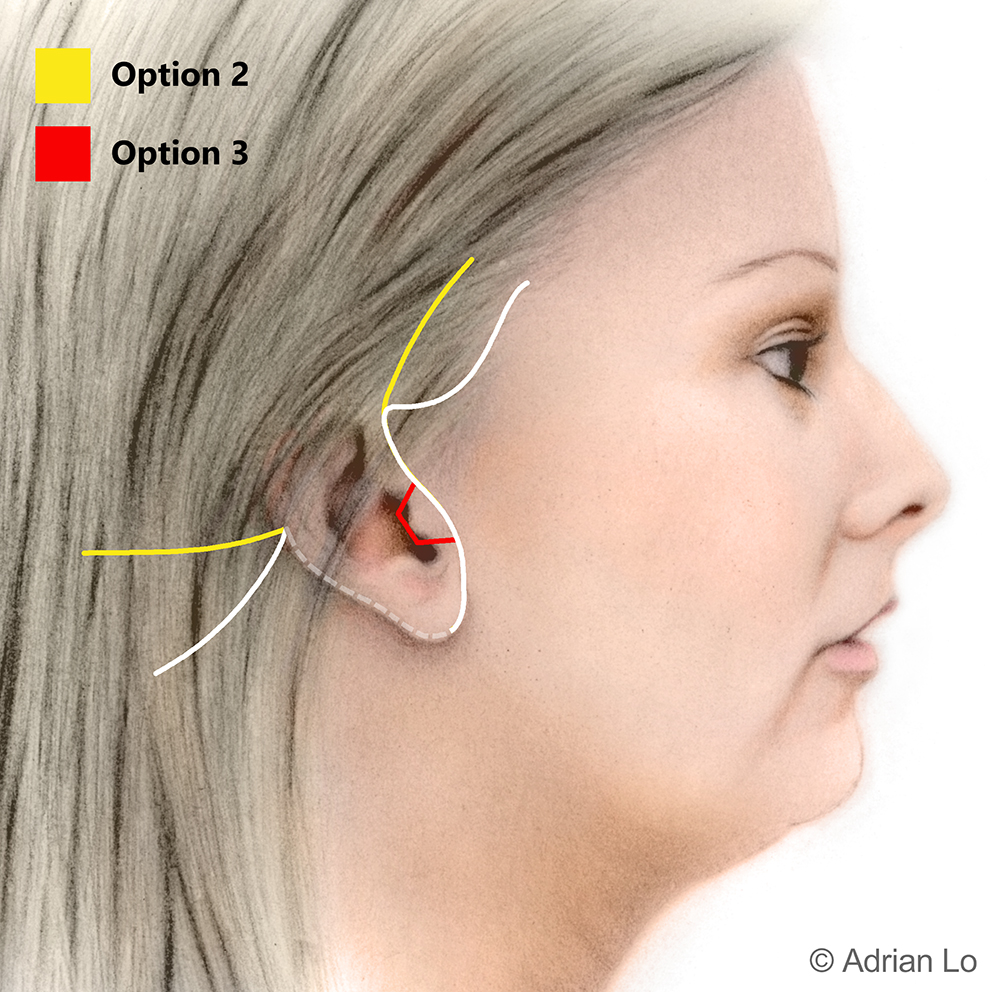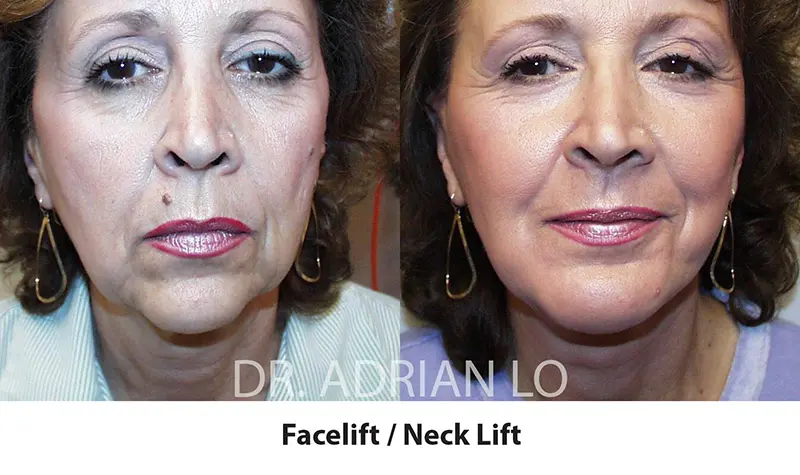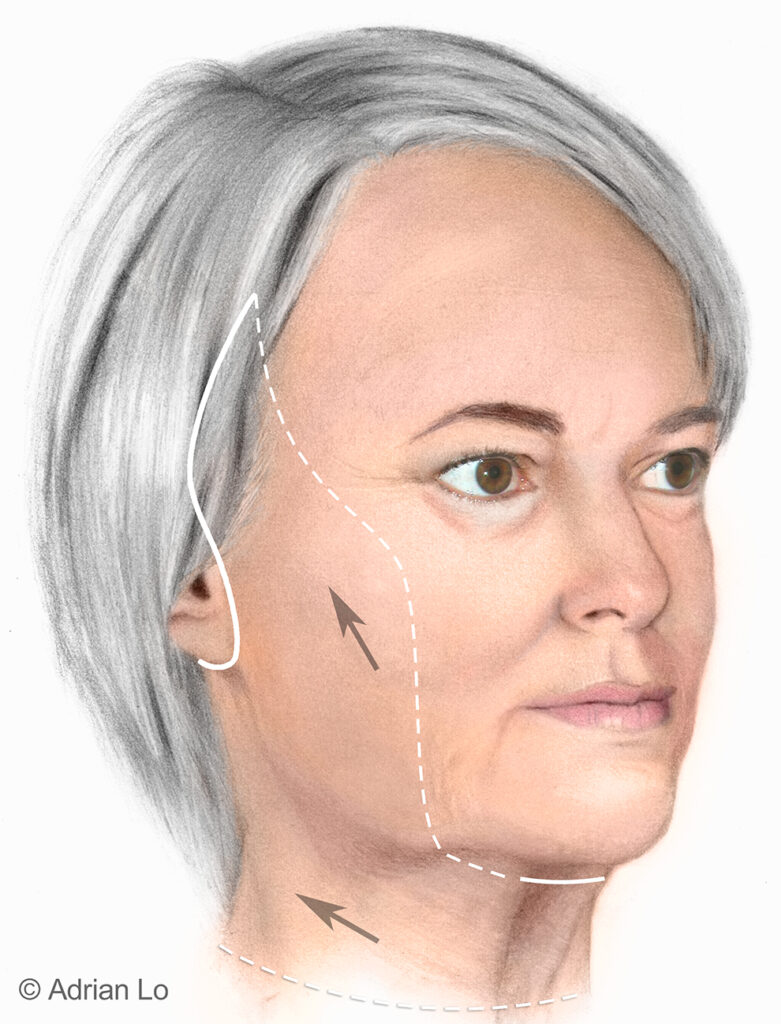Transformation comes with a story – and sometimes, that story leaves a mark.
A facelift is a transformative procedure for many people to turn back the clock. The incision length and placement used in a facelift procedure is used to enhance facial rejuvenation and reverse the signs of aging. These incisions will leave facelift scars that usually heal beautifully and remain hidden.
However, it is important to know about your facelift incisions or facelift scars and how to lessen their visibility or appearance.
To learn about the facelift procedure – call us at our Philadelphia plastic surgery offices to get started!
Types of Facelift Scars
Surgical techniques are not one-size-fits-all, and neither are the scars they create. The appearance and healing of facelift scars can vary significantly based on surgical techniques as well as individual factors, impacting the final aesthetic outcome.
The placement, length, and technique of incisions play a fundamental role in determining how visible and prominent scars will ultimately be.
Traditional Facelift Scars
Traditional Facelift Scars
Traditional facelift incisions are meticulously planned to blend with the natural contours of the face. Typically, these incisions begin near the hairline at the temples, curve around the ear, and extend into the natural creases behind the ear and into the occipital hairline.

The strategic placement allows plastic surgeons to minimize visible scarring while providing comprehensive facial rejuvenation.
The length of these incisions vary depending on the extent of correction needed. Longer incisions might be necessary for more extensive facial rejuvenation, while shorter approaches can address more subtle signs of aging. Patients should understand that the initial appearance of scars will be most pronounced in the weeks following surgery, with significant improvement occurring over 3 to 6 months.
Mini Facelift Scars
Mini facelifts are popular amongst the 35 to 45 year old population. These patients do not need a full facelift but benefit from improvement of the jowls and a smoother jaw line. Mini facelifts do not usually correct the neck area, which is best treated by a full facelift.
Mini facelifts are a more targeted approach to facial rejuvenation concentrating on the mid- and lower face. The procedure utilizes shorter, more discreet incisions that typically result in less lengthy scars.
Concentrated around the ears and along the hairline, mini facelift scars are strategically placed to minimize visibility while providing aesthetic improvements.
The surgical technique means smaller incisions and potentially faster healing. Patients often appreciate the reduced scarring and shorter recovery time associated with the mini facelift procedure. The suitability of a mini facelift depends on individual aging patterns and aesthetic goals.
Deep Plane Facelift Scars
The Deep Plane facelift represents an advanced approach to facial rejuvenation. This technique involves repositioning deeper facial layers, also known as the SMAS layer, which can lead to more natural-looking results and potentially less prominent scarring. Incisions are precisely placed to access the underlying facial structures.
Deep Plane facelifts allow plastic surgeons to create more comprehensive and long-lasting results while maintaining a focus on minimal scarring.
Timeline of Facelift Scar Healing

Scar healing is a complex, multistage process that requires patience and proper care. The facelift scar healing time can range from several weeks to a full year for complete scar maturation. Understanding the progression can help patients set realistic expectations and actively participate in their recovery.
Initial Recovery Phase (1-2 Weeks)
The initial weeks following a facelift are characterized by initial wound healing. Incisions will appear red, potentially raised, and may feel tender. Proper wound care during this phase is paramount.
Patients will need to follow strict protocols to protect healing incisions, including gentle cleansing, avoiding direct sunlight, and using recommended ointments.
Secondary Healing Phase (2-8 Weeks)
During this period, scar tissue begins to form and remodel. The incisions will start to fade from bright red to a softer, less prominent color.
Patients might notice some tissue hardening or slight irregularities – this is a normal part of the healing process. Gentle massage and recommended treatments can help minimize scar development.
Final Maturation Phase (6-12 Months)
The final stage of scar healing represents a remarkable transformation. Scars continue to remodel, flatten, and blend with surrounding skin.
Most patients will see significant improvement in scar appearance, with many scars becoming nearly imperceptible when proper care and techniques are employed.
Minimizing Facelift Scars
There are multiple strategies for how to minimize facelift scars, ranging from pre-surgical preparation to advanced medical treatments.
Pre-Surgery Preparation
Optimal scar healing begins before the procedure. Patients should focus on overall health, maintaining a balanced diet rich in nutrients that support wound healing. Vitamin supplementation may be recommended. Proper hydration, avoiding smoking for at least 2 weeks before the surgery and managing underlying health conditions can significantly impact surgical outcomes.
Post-Surgery Care
A comprehensive post-facelift recovery plan is essential for optimal scar healing and aesthetic outcomes. Comprehensive incision care is essential for minimizing scar formation.
This includes following post-operative instructions precisely, protecting incisions from sun exposure, and using recommended scar management products. Facelift scar products that may be recommended include silicone sheets, liquid silicone and steroid creams.
Professional Treatments

Advanced scar treatment options have revolutionized how we approach minimizing surgical scarring, including facelift scars.
Laser Resurfacing Therapy
Advanced laser treatments, including CO2 fractional lasers and Erbium YAG systems operating at 2940 nm wavelength, offer powerful options for scar improvement.
These techniques can help reduce scar visibility, improve texture, and promote more uniform skin appearance. The precise targeting of laser therapy, which penetrates to a depth of 0.5-2mm, allows for scar management with minimal downtime of 1 to 3 days.
Medical-Grade Scar Treatments
Professional-level interventions include topical treatments with vitamin C serums, injectable therapies like cortisone and specialized scar treatment protocols using medical-grade silicone sheets worn 12 to 23 hours daily.
These modalities can significantly improve scar appearance within 8-12 weeks and support the body’s natural healing processes through enhanced collagen remodeling.
Advanced Microneedling
Microneedling represents an innovative approach to scar reduction, utilizing sterile needles ranging from 0.5-2.5mm in length. Creating these controlled micro-injuries at precisely calibrated depths stimulates natural collagen production helping to smooth and refine scar tissue over 4-6 treatment sessions spaced 4-6 weeks apart.
Scar Revision Surgery
In situations where facial scars exceed 2 mm in width or depth, scar revision surgery might be recommended to further improve the appearance of noticeable facelift scars.
Start Your Facelift Journey with Dr. Adrian Lo
Every patient’s journey is unique. At Dr. Adrian Lo, we pride ourselves on delivering personalized care that addresses individual aesthetic goals and concerns. Our commitment to patient satisfaction means comprehensive support throughout your transformation.
We invite you to schedule a consultation and explore how we can help you achieve your aesthetic vision with minimal scarring and maximum confidence!
